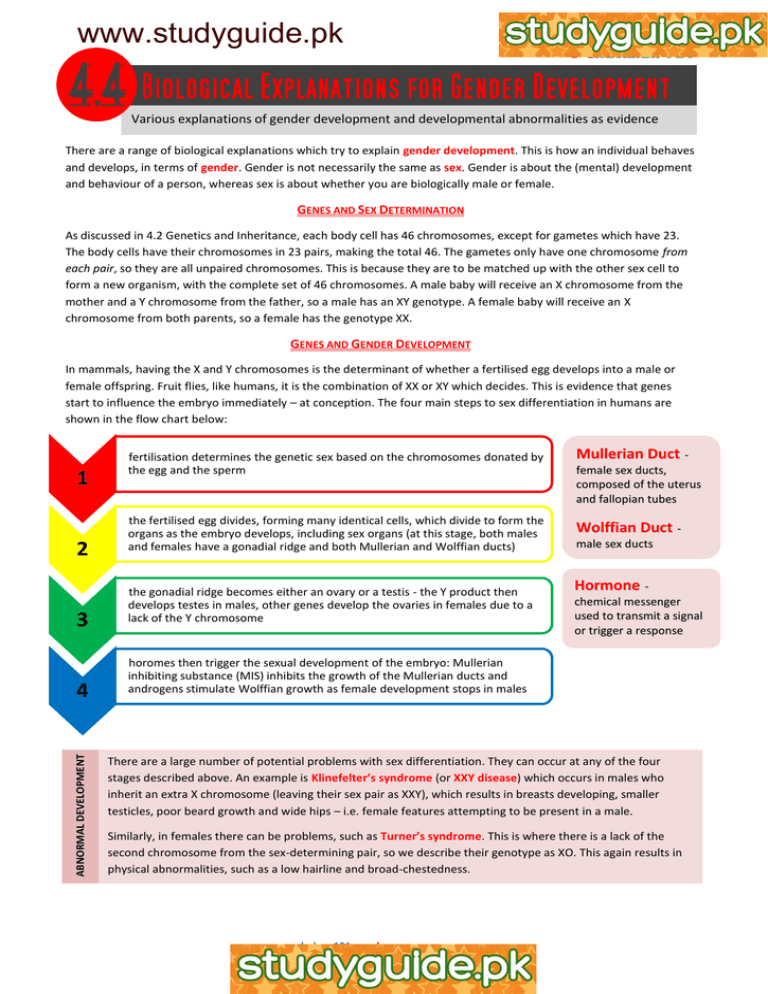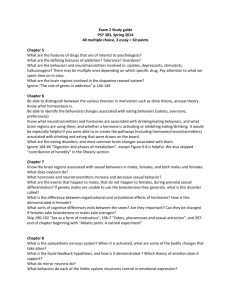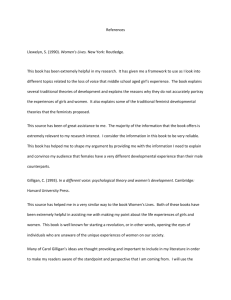Document 10704299
advertisement

www.studyguide.pk Various explanations of gender development and developmental abnormalities as evidence There are a range of biological explanations which try to explain gender development. This is how an individual behaves and develops, in terms of gender. Gender is not necessarily the same as sex. Gender is about the (mental) development and behaviour of a person, whereas sex is about whether you are biologically male or female. GENES AND SEX DETERMINATION As discussed in 4.2 Genetics and Inheritance, each body cell has 46 chromosomes, except for gametes which have 23. The body cells have their chromosomes in 23 pairs, making the total 46. The gametes only have one chromosome from each pair, so they are all unpaired chromosomes. This is because they are to be matched up with the other sex cell to form a new organism, with the complete set of 46 chromosomes. A male baby will receive an X chromosome from the mother and a Y chromosome from the father, so a male has an XY genotype. A female baby will receive an X chromosome from both parents, so a female has the genotype XX. GENES AND GENDER DEVELOPMENT In mammals, having the X and Y chromosomes is the determinant of whether a fertilised egg develops into a male or female offspring. Fruit flies, like humans, it is the combination of XX or XY which decides. This is evidence that genes start to influence the embryo immediately – at conception. The four main steps to sex differentiation in humans are shown in the flow chart below: 1 2 3 4 ABNORMAL DEVELOPMENT d •fertilisation determines the genetic sex based on the chromosomes donated by the egg and the sperm Mullerian Duct - •the fertilised egg divides, forming many identical cells, which divide to form the organs as the embryo develops, including sex organs (at this stage, both males and females have a gonadial ridge and both Mullerian and Wolffian ducts) Wolffian Duct - •the gonadial ridge becomes either an ovary or a testis - the Y product then develops testes in males, other genes develop the ovaries in females due to a lack of the Y chromosome female sex ducts, composed of the uterus and fallopian tubes male sex ducts Hormone chemical messenger used to transmit a signal or trigger a response •horomes then trigger the sexual development of the embryo: Mullerian inhibiting substance (MIS) inhibits the growth of the Mullerian ducts and androgens stimulate Wolffian growth as female development stops in males There are a large number of potential problems with sex differentiation. They can occur at any of the four stages described above. An example is Klinefelter’s syndrome (or XXY disease) which occurs in males who inherit an extra X chromosome (leaving their sex pair as XXY), which results in breasts developing, smaller testicles, poor beard growth and wide hips – i.e. female features attempting to be present in a male. Similarly, in females there can be problems, such as Turner’s syndrome. This is where there is a lack of the second chromosome from the sex-determining pair, so we describe their genotype as XO. This again results in physical abnormalities, such as a low hairline and broad-chestedness. www.aspsychology101.wordpress.com www.studyguide.pk HORMONES AND GENDER DEVELOPMENT A hormone is similar to a neurotransmitter, except it does not work solely in nerve cells. They are similar in the sense of that they carry messages to trigger cellular responses. Hormones affect mood, metabolism, growth and development. However, their messages are passed on a lot more slowly as they travel through the bloodstream, not due to electrical impulses. Hormones are produced in endocrine glands, which include the pituitary gland, pineal gland, adrenal gland and thyroid gland. In males, they are also produced in the testes, and likewise in the ovaries in females. Just a minute amount of hormone can trigger large changes in an organism, and having too much or too little will cause problems. The female hormones are oestrogen and progesterone and the male hormones are androgens (an example of an androgen is testosterone). All of these are reproductive hormones. Such hormones cause gender differentiation and can affect male and female brains to develop differently. They are essential in gender differentiation as their production results in the development of male and female sex organs. In the brain, hormones can affect working memory and reference memory. Working Memory short-term memory Reference Memory long-term memory ABNORMAL DEVELOPMENT Hormones might also be involved in the experience of pain, and why some diseases associated with chronic pain occur more frequently in females. PET scans have been used to see how pain affects the brain. In one study, men had an increase in the amount of endorphins released compared to women, and women reported more feelings of pain. These females were tested at the beginning of their menstrual cycle, when levels of oestrogen were low. They were then given oestrogen and retested later during their cycles, where more endorphins were released and they said the pain was less severe. This is evidence of hormones affecting gender behaviour. There is more evidence supporting the role of hormones in gender development with abnormal development with androgenital syndrome. This is caused by the overproduction of androgens, and a deficiency in aldosterone and cortisol. In males, this may result in an enlarged penis and small testes, females may have ambiguous genitals. The disorder can be causes by congenital adrenal hyperplasia linked with the three hormones, produced by the adrenal gland. If during development the adrenal gland does not produce enough cortisol, then the pituitary gland is stimulated to release the hormone ACTH. This travels to the adrenal gland and causes its cortex to increase in thickness (become hyperplasic). This, together with the increased production of testosterone can cause early sexual development. In females, the excess testosterone causes abnormal genital development in the embryo, and unwanted hair growth and irregular periods in adult females. BRAIN STRUCTURE AND GENDER DEVELOPMENT The brain is divided into two halves: the right hemisphere and the left hemisphere. Left hemisphere Receives information from and controls the right-hand side of the body, and receives information from the right visual field Right hemisphere Receives information from and controls the left-hand side of the body, and receives information from the left visual field The left hemisphere controls: speech, language and comprehension analysis and calculations time and sequencing recognition of words, letters and numbers The right hemisphere controls: creativity spatial ability context/perception recognition of faces, places and objects www.aspsychology101.wordpress.com www.studyguide.pk Generally, it is thought that females tend to use both sides of the brain equally, and males seem to use the right side of the brain more. This is because it is said that the corpus callosum (a large network of fibres connecting the two hemispheres) is larger in female brains. Lateralisation one hemisphere which is used more than the other There is also said to be a gender difference in visuospatial ability. Visuospatial tasks require the use of the right hemisphere, which is the one that male brains are thought to have preference towards. Studies have shown that males do use this side more than the left, a quality females do not share. This means that generally males should be better at visuospatial tasks and maths. However, studies have not constantly been able to show a correlation between the size of the corpus callosum and gender. Whilst its size differs between the individual, there is no distinct relationship between the two. These theories had been put together around 30 years ago, and whilst there is still agreement that it is true, there is now doubt. Various pieces of evidence for brain lateralisation include: ABNORMAL DEVELOPMENT If the idea of visuospatial tasks using the right side and verbal tasks the left side is true, it is thought that brain damage to either side would lead to problems with their respective tasks, however, studies which have worked with people suffering brain damage to only one side of the brain have shown that this is only true for males, not females Women with Turner’s syndrome (see before) use both sides of the brain even more evenly and display very feminine behaviour Men who do not have regular exposure to androgens in the womb tend to use both sides of the brain more In patients with damage to the left hemisphere, speech difficulties occur more commonly in males There is more abnormal developmental evidence supporting brain structure theories. Child abuse and neglect appear to lead to brain abnormalities. Whilst a child may be born with a healthy brain and all the neurones, the brain continues to develop throughout childhood and adolescence, and can be damaged by environmental influences at any stage. The corpus callosum of anyone abused as a child is smaller in adults. Males who had suffered neglect had a reduction of 24-42% in size, but those who had been sexually abused as boys had no change. Females who had suffered neglect had no change, but those who were neglected decreased between 18-30%. This shows us there are differences in the use of each hemisphere and how they can be affected. BIOLOGICAL EXPLANATIONS FOR GENDER DEVELOPMENT: AN EVALUATION A brief evaluation of the biological explanations of gender development is outlined below: The results of these explanations have been based on tests which can be replicated, so reliability can be tested Several different research methods have been used (such as brain scans, laboratory experiments, twin and adoption studies, and animal studies) and they all seem to result in similar findings, so the conclusions tend to be more reliable Most of the studies are usually done on animals, because of ethical constraints with humans – their genes and hormones are not always the same as ours, so the results may not be applicable to humans, making them hard to generalise These explanations focus solely on biological aspects, such as differences in male and female brains based on structure and function, but the results may just only be down to males and females using different strategies (strategies being a result of upbringing), so they do not consider environmental aspects www.aspsychology101.wordpress.com







